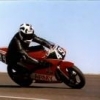
Formula A - the beginnings
#1

Posted 18 January 2011 - 06:52
I want to know about Formula A in the US, the 5-litre formula that led to Formula 5000 round the world.
What were the initial rules? Was there ever much following, were many competing?
And if so, in what?
Thanking you gentlemen in anticipation...
#3

Posted 18 January 2011 - 08:44
#4

Posted 18 January 2011 - 08:47
In 1962 and 1963 the USAC road-racing series drew entries from a few F1 (or ex-F1) cars that owners had bought for the annual US GP
This led to talk of a stock-block series called Formula 366 (with engines up to 366ci (6000cc), but it never happened, and by 1964 the USAC series was finished, so that the only races available to woners of single-seaters were the SCCA libre events
But in 1965 the SCCA replaced its libre and FJ classes were a new structure, based loosely on F1, F2 and F3. The new classes were Formula A (3 litres), FB (1600cc) and FC (1100cc). Very few cars appeared in FA, a couple of upgraded FJ cars, a few modified sportscars, and an old Cooper T53, but FB was much more strongly supported (and the cars faster than most FA entries), especially with input from of the California-based Formula Racing Association, which ran its own races
In 1967 the SCCA introduced a ‘pro’ series for single-seaters, still under the same Formula A/B/C rules, and called the Grand Prix Championship. This attracted more entries into the 3-litre class, but support in general was still half-hearted until the following year, when the clubs decided to admit into FA cars with 5-litre stock-block engines. Lola in England came up with a new design (the T140) and Eagle, LeGrand, Eisert and McKee were among American manufacturers building cars. Among the drivers, a lot of established sportscar front-runners joined in, though it was FB graduate Lou Sell who won the championship in an Eagle, from George Wintersteen in another Eagle and Bud Morley in a converted CanAm McLaren. Sell won five of the eight rounds, Wintersteen two and Jerry Hansen (Lola) the other.
There was another step forward in 1969 when the series, now renamed the Continental Championship, attracted works entries from Europe. An Eagle was again the title winner, driven by TransAm Porsche graduate (and TNFer) Tony Adamowicz, with Englishman David Hobbs (Surtees TS5) second, Sam Posey (Eagle) third and Wintersteen (Lola) sharing fourth place with Canadian Jon Cannon (Eagle)
That same year the British had inaugurated the basically similar Formula 5000, and cars were also racing in South Safrica, and before the next Northern Hemisphere season were also competing in the Tasman Championship in New Zealand and Australia
Edited by David McKinney, 18 January 2011 - 08:48.
#5

Posted 18 January 2011 - 09:36
Thanks for the rundown, David, I rather thought it had been around - in 5-litre stockblock form - for longer than that.
#6

Posted 18 January 2011 - 10:16
ExactlySo it came just in time, basically, to replace the Tasman Cup 2.5s as F1 people became less interested in an off-season series...
A lot of people (in NZ, anyway) blamed F5000 for killing off the tradition of F1 stars doing the Tasman between seasons, but it was already beginning to happen. It was not the change of formula that did it, it was increasing pressures on the "stars" to stay close to base
#7

Posted 18 January 2011 - 11:00
And the number of races in the World Championship series grew as well. Then there was the growing importance of tyre testing, with a lot of the drivers committed to go to South Africa to test tyres for the coming season during January and February.
#8

Posted 18 January 2011 - 11:33
#9

Posted 18 January 2011 - 11:53
#10

Posted 18 January 2011 - 12:09
Would there also have been a reluctance to downsize Cosworths to 2.5 litres for a handful of races on the far side of the world ?
It was eight races - at a time when the World Championship consisted of 11 or 12.
#11

Posted 18 January 2011 - 12:12
The additional four races in the major series would have added a lot of pressure.
#12

Posted 18 January 2011 - 12:20
I suspect it was more to do with F1 drivers focusing on F1 instead of doing F2, Can-Am, sports cars and Tasman as they had tended to do in the 1960s. The Tasman organisers had to choose between F2 and F5000 to replace the ageing 2.5-litre formula and it's by no means certain that they made the wrong choice.
#13

Posted 18 January 2011 - 12:47
It would never have worked as well as F5000.
#14

Posted 18 January 2011 - 12:57
The Tasman organisers had to choose between F2 and F5000 to replace the ageing 2.5-litre formula and it's by no means certain that they made the wrong choice.
[/quote]
A few years later when the F5000 series began to wane, what was then Formula Pacific/Atlantic was seemingly rushed in as a substitiute, only for hands to be thrown up at the considerable cost, if I recall...
#15

Posted 18 January 2011 - 13:26
They ate components. Differentials that weren't up to the torque, engines that were built for road cars, brakes that had to stop too much weight from too much speed, they were an endless drag on money.
If there was an outcry about cost for FAtlantic, it would have been the cost of the changeover and the perceived lack of return for the driver. That's the seat-of-the-pants return.
#16

Posted 18 January 2011 - 13:57
Yes and noThe move of the South African GP from some time around 1 January to early March is unlikely to have been a major factor in the decline of the Tasman series. Nor the expansion of the F1 season into Jan and Feb as that happened a few years later. Nor, I would suggest, pre-season tyre testing as there was plenty of time for that between the South African GP in early March and the start of the European season in May.
I suspect it was more to do with F1 drivers focusing on F1 instead of doing F2, Can-Am, sports cars and Tasman as they had tended to do in the 1960s. The Tasman organisers had to choose between F2 and F5000 to replace the ageing 2.5-litre formula and it's by no means certain that they made the wrong choice.
As one who lived through the arguments at the time (hem, hem!) the decision to replace the 2.5 formula wasn't because of its age ... in the last couple of years engines were supplied by Cosworth, Ferrari, BRM and Repco, and there's no reason to believe they wouldb't have continued had the formula remained unchanged.
By 1969 it was obvious the F1 stars were increasingly reluctant to take part, the reason cited being the lengthening F1 calendar and increased testing duties (in spite of what you say
So the decision was to change the formula - F1, F2 and F5000 were all discussed. F1 was ruled out for the above reasons (as well as for costs to locals, as it had been ruled out before). F2 wasn't an option because virtually everyone in the host countries would have had to buy new cars - expense again. American FA was ruled out because it permitted 3-litre race engines (see above) and British F5000 wasn't on either, because it limited racing engines to 2000cc, and all the local cars were 2.5s. Therefore a separate Tasman Formula was devised, for stock-block engines up to 5 litres (same as FA and F5000) and racing engines of 2.5 (different from either)
That allowed stock-block entries from Europe and North America, plus any locals who wanted to buy (or build) equivalent cars, and other locals with 2.5 engines. And, of course, it was a 2.5 (actually 2.4) car which won the first 5-litre Tasman Championship
#17

Posted 18 January 2011 - 14:58
The early years of FA, prior to the introduction of the five liter pushrod V-8s, saw very few entries. Largely, I imagine, due to the absence of proper used F-1 cars and the fact that a properly engineered FB chassis with twin cam Ford was faster and cheaper.
The pre-5.0 FA winners at the Runoffs were two. 1966, Harry McIntosh in what SCCA records list as a "Brabham Climax V-8". No chassis designation listed. Could it have been a BT-7 or BT-11? In 1967 Chuck Kirkbride is listed as winning in a "Lotus 23-Climax". Again, no real details, but perhaps a two liter Climax four in a 23 chassis? It must be pointed out that Kirkbride was the only finisher in the FA class...
As David mentions, in 1967 the SCCA created a pro series for formula cars, called the Grand Prix Championship. While the occasional FA car showed up, it was all FB cars in the top positions. Gus Hutchinson, who is the subject of his own thread here on TNF, was the Champion in a Lotus 41 FB. Interestingly enough, in 1970 Gus won two F-5000 pro races in a Brabham BT-26A, which I believe may be the only non pushrod V-8 wins in the F-5000 years of 1968-76.
Tom
#18

Posted 18 January 2011 - 15:01
David's post #4 very nicely sums up the development of FA in the US with the evolution of open wheel racing here progressing from the early FJs in 1960 to the full blown F-5000s.
The early years of FA, prior to the introduction of the five liter pushrod V-8s, saw very few entries. Largely, I imagine, due to the absence of proper used F-1 cars and the fact that a properly engineered FB chassis with twin cam Ford was faster and cheaper.
The pre-5.0 FA winners at the Runoffs were two. 1966, Harry McIntosh in what SCCA records list as a "Brabham Climax V-8". No chassis designation listed. Could it have been a BT-7 or BT-11? In 1967 Chuck Kirkbride is listed as winning in a "Lotus 23-Climax". Again, no real details, but perhaps a two liter Climax four in a 23 chassis? It must be pointed out that Kirkbride was the only finisher in the FA class...
http://www.oldracingcars.com/f5000/
A BT7 and a Lotus 18 respectively.
#19

Posted 18 January 2011 - 15:24
David's post #4 very nicely sums up the development of FA in the US with the evolution of open wheel racing here progressing from the early FJs in 1960 to the full blown F-5000s.
The early years of FA, prior to the introduction of the five liter pushrod V-8s, saw very few entries. Largely, I imagine, due to the absence of proper used F-1 cars and the fact that a properly engineered FB chassis with twin cam Ford was faster and cheaper.
The pre-5.0 FA winners at the Runoffs were two. 1966, Harry McIntosh in what SCCA records list as a "Brabham Climax V-8". No chassis designation listed. Could it have been a BT-7 or BT-11? In 1967 Chuck Kirkbride is listed as winning in a "Lotus 23-Climax". Again, no real details, but perhaps a two liter Climax four in a 23 chassis? It must be pointed out that Kirkbride was the only finisher in the FA class...
As David mentions, in 1967 the SCCA created a pro series for formula cars, called the Grand Prix Championship. While the occasional FA car showed up, it was all FB cars in the top positions. Gus Hutchinson, who is the subject of his own thread here on TNF, was the Champion in a Lotus 41 FB. Interestingly enough, in 1970 Gus won two F-5000 pro races in a Brabham BT-26A, which I believe may be the only non pushrod V-8 wins in the F-5000 years of 1968-76.
Tom
Tom
I'm fairly certain that Chuck Kirkbride was driving an F1 Lotus 18-Climax, not a 23. I have the chassis number noted somewhere, as I believe this was the car (#372?) that Chris Mann acquired, it has been in Kirkbride's collection for quite a while.
Michael
Advertisement
#20

Posted 18 January 2011 - 15:52
Yes, he's right; it was 372.
#21

Posted 18 January 2011 - 20:14
#22

Posted 18 January 2011 - 21:02
The Ferraris and Maseratis in South America with Chevrolet 283s, for instance, Aussie Miller's Corvette with similar, there was another Cooper here raced by Des Lascelles (using the word 'raced' very loosely) which had a V8 in it for a long time (Bob Minogue had it too) and there were hillclimb cars.
I think there must have been an Olds or Buick-powered Brabham or Lotus somewhere that fitted in, even if you weren't counting cars like the Scarab (built for FIntercontinental) and the BRM that got its engine.
But I would rather keep on track with what happened in FA in the US, which I think we're pretty much seeing fully covered here.
#23

Posted 18 January 2011 - 21:43
A BT7 and a Lotus 18 respectively.
Thanks, Allen and Michael. The SCCA records said '23', which seemed odd to me. Once again, this points out that old SCCA records cannot be taken at face value without additional verification.Tom
I'm fairly certain that Chuck Kirkbride was driving an F1 Lotus 18-Climax, not a 23. I have the chassis number noted somewhere, as I believe this was the car (#372?) that Chris Mann acquired, it has been in Kirkbride's collection for quite a while.
Michael
Tom
#24

Posted 18 January 2011 - 22:38
Neat. But a Lotus 18 was a pretty old car by then, though it was mentioned it was the only survivor, wasn't it?
#25

Posted 18 January 2011 - 22:57
I think Ray answered that adequatelyI wonder was the Stanton Corvette in rear engine single seater form the worlds first FA/F5000 car ..........David?
The Begg-Chevrolet single-seater that became the Begg-Daimler was subsequently claimed to have been NZ's first 5000 but, by the same token, it wasn't built for F5000. And had a 5.9-litre engine anyway...
#26

Posted 19 January 2011 - 07:44

Uploaded with ImageShack.us
The CERV stood for ( Chevrolet Engineering Research vehicle).
Made in 1960 at GM tech centere it was designed by Zora Auks-Duntov
Mainly as a test bed for the coming Corvette independent rea end.
It was originally fitted with a 4.7 literV8 then later it had a 6.2 liter
Motor and Hillborn fuel injection and alloy heads 1962.
It wasdriven through a corvette 4speed gearbox an diff rated at 400Hp.
It was the first race car to be fitted with a rubber aircraft style fuel tank
The Weak link was it had DRUMS brake all round and this with a top speed
of 268kph must have been a heart in mouth at the corners.
It was test driven at Riverside in1961 by the Great Striling Moss
and Dan Gurney now that would have been a sight to see.
It the did Firestone testing to evalate tyre widths to cope with the race loads
and eventuallyit went back in the GM Tech center.
Before going to the BriggsCunningham Auto Museum in Costa Mesa
in California.
It was,i would say the 1stt F5000 car or Formula A in a a time
when they were not on the radar to us people in racing world.

Uploaded with ImageShack.us
Edited by eldougo, 19 January 2011 - 08:04.
#27

Posted 19 January 2011 - 07:57
Seems to me it was around in the early sixties, so it would have been '59, which would also have made it a pretty advanced car. Except for the brakes, of course.
#28

Posted 19 January 2011 - 08:05
#29

Posted 19 January 2011 - 18:15
#30

Posted 19 January 2011 - 19:39
The picture is of CERV II. What Doug's talking about is CERV I:1960??? With those tyres???
http://forums.autosp...showtopic=46147
#31

Posted 19 January 2011 - 20:44
Duntov had a hand in a lot of stuff in his lifetime, a man with a real history!
#32

Posted 19 January 2011 - 21:41
The picture is of CERV II. What Doug's talking about is CERV I:
http://forums.autosp...showtopic=46147
Ah, thanks. Didn't remember that thread, and Dougo's post was ambiguous...
#33

Posted 19 January 2011 - 22:47
Flagging/Marshaling at Turn Seven, I did see it, and it was one of many remarkable sights that week of the U.S. Grand Prix.It was test driven at Riverside in1961 by the Great Striling Moss
and Dan Gurney now that would have been a sight to see.
RIR "next" page
#34

Posted 19 January 2011 - 22:49
It was the first race car to be fitted with a rubber aircraft style fuel tank
I'm quite likely to be wrong, but didn't the circa 1950 Trimax 500cc F3 car have bag tanks?
#35

Posted 19 January 2011 - 23:03
Moss was the driver in an exhibition run at the Nov., 1960, USGP at Riverside. I remember reading about it in contemporary magazines, etc.
Tom
Edited by RA Historian, 19 January 2011 - 23:04.
#36

Posted 20 January 2011 - 06:15
The picture is of CERV II. What Doug's talking about is CERV I:
http://forums.autosp...showtopic=46147
I was talking about the CERV 1 that is what it is called in the report ,they go on to mention it was a second generation CERV1.
Edited by eldougo, 20 January 2011 - 06:16.
#38

Posted 20 January 2011 - 08:41
I'll see if I have that issue here.
#39

Posted 22 January 2011 - 00:13
Who can fill me in here?
I want to know about Formula A in the US, the 5-litre formula that led to Formula 5000 round the world.
What were the initial rules? Was there ever much following, were many competing?
And if so, in what?
Thanking you gentlemen in anticipation...
I have a little Formula A history as my Dad raced in the Southwest Div SCCA in a DeTomaso formula "A" back in 1966. The car was purchased from John Mecom in 1965.
Advertisement
#40

Posted 22 January 2011 - 00:20
Do you have pictures, what can you tell me about that car?
My e.mail is below if necessary.
#41

Posted 22 January 2011 - 01:54
Ray I e-mailed some pics.. I wish I could load them for others to view, but don't seem to have the right skills! Fell free to load them if you can.That's great, and welcome to the forum...
Do you have pictures, what can you tell me about that car?
My e.mail is below if necessary.
#42

Posted 22 January 2011 - 02:22
Tom did you see any records indicating the entry of a DeTomaso formula A 1966?Thanks, Allen and Michael. The SCCA records said '23', which seemed odd to me. Once again, this points out that old SCCA records cannot be taken at face value without additional verification.
Tom
#43

Posted 22 January 2011 - 08:11
About a year or two ago there was an odd mystery Detomaso F/A formula 5000 Indy car on ebay for sale in the US, was listed and relisted several times.I have a little Formula A history as my Dad raced in the Southwest Div SCCA in a DeTomaso formula "A" back in 1966. The car was purchased from John Mecom in 1965.
in the end it was thought to be an early F JR car with a V8 stuffed into it at some point
here is a link to it for sale now without the V8 and wide rims http://www.carandcla...uk/car/C194561/
and also http://www.racecarsd...on_Project.html
#44

Posted 22 January 2011 - 09:18
David's post #4 very nicely sums up the development of FA in the US with the evolution of open wheel racing here progressing from the early FJs in 1960 to the full blown F-5000s.
The early years of FA, prior to the introduction of the five liter pushrod V-8s, saw very few entries. Largely, I imagine, due to the absence of proper used F-1 cars and the fact that a properly engineered FB chassis with twin cam Ford was faster and cheaper.
The pre-5.0 FA winners at the Runoffs were two. 1966, Harry McIntosh in what SCCA records list as a "Brabham Climax V-8". No chassis designation listed. Could it have been a BT-7 or BT-11? In 1967 Chuck Kirkbride is listed as winning in a "Lotus 23-Climax". Again, no real details, but perhaps a two liter Climax four in a 23 chassis? It must be pointed out that Kirkbride was the only finisher in the FA class...
As David mentions, in 1967 the SCCA created a pro series for formula cars, called the Grand Prix Championship. While the occasional FA car showed up, it was all FB cars in the top positions. Gus Hutchinson, who is the subject of his own thread here on TNF, was the Champion in a Lotus 41 FB. Interestingly enough, in 1970 Gus won two F-5000 pro races in a Brabham BT-26A, which I believe may be the only non pushrod V-8 wins in the F-5000 years of 1968-76.
Tom
Tom,
Any info about Guy Wooley's Cooper Climax ?
what type it was where it is now
He was one of my fathers cohorts back in the day
I was very young at the time but remember it at Wilmot and R/A
Ted
#45

Posted 22 January 2011 - 09:40
About a year or two ago there was an odd mystery Detomaso F/A formula 5000 Indy car on ebay for sale in the US, was listed and relisted several times.
in the end it was thought to be an early F JR car with a V8 stuffed into it at some point
here is a link to it for sale now without the V8 and wide rims http://www.carandcla...uk/car/C194561/
and also http://www.racecarsd...on_Project.html
Wow....... would have handled like a roller skate......... It would be worth more as a F5000, but if it has the history, I'd love to see someone restore it as a Junior.
#46

Posted 22 January 2011 - 10:17
Ray I e-mailed some pics.. I wish I could load them for others to view, but don't seem to have the right skills! Fell free to load them if you can.
Hi Rick. Here are your pictures. The Formula A 'Pro' series only started in 1967 so SCCA SouthWest Divisional Formula A would have been your father's only option in 1966. He finished second in that season's championship, behind Jack Saunders in a Lotus 21. What engine was in your father's car?
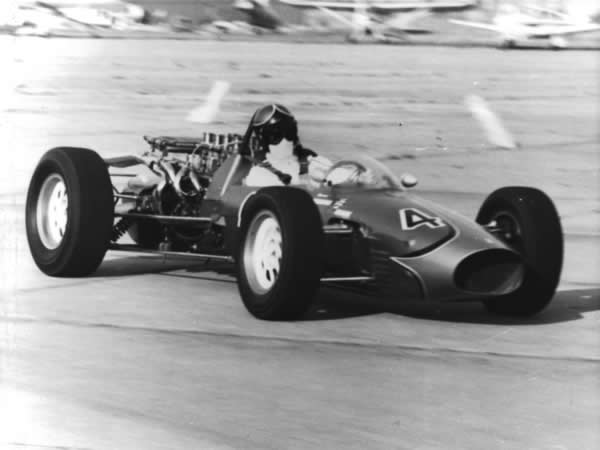
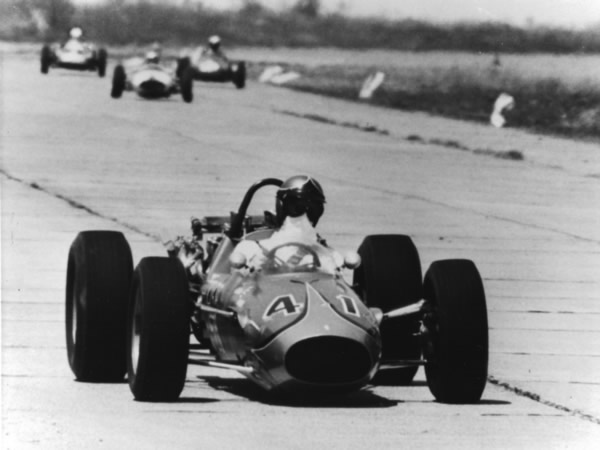
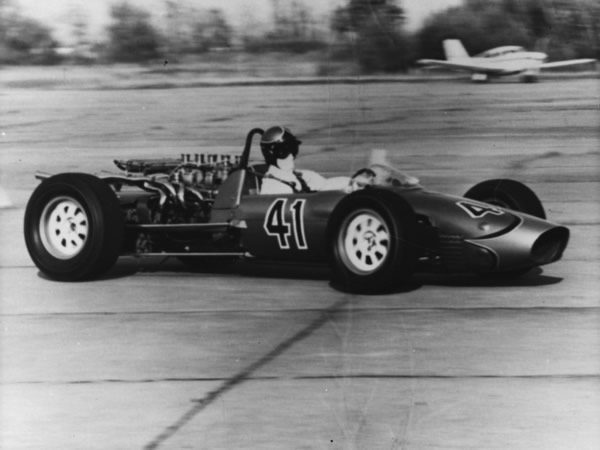
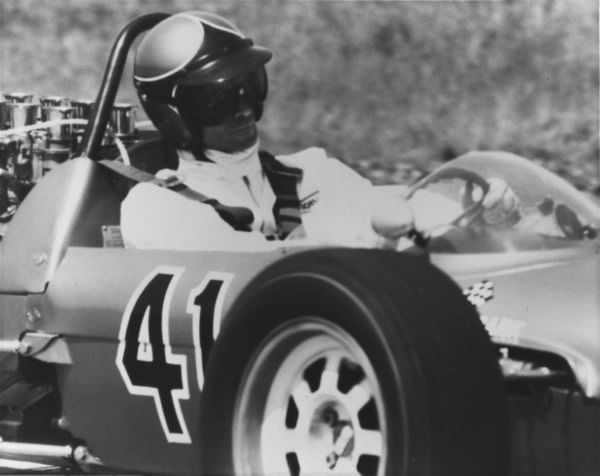
#47

Posted 22 January 2011 - 13:28
And thanks, Rick, for sending the pics around. What was your father's first name, too?
#48

Posted 22 January 2011 - 14:56
No idea I'm afraid. But this might be relevant.So Allen, what sort of De Tomaso is it?
Driver was Bill Frank: http://www.oldracing...6/southwestdiv/And thanks, Rick, for sending the pics around. What was your father's first name, too?
#49

Posted 22 January 2011 - 16:01
Tom,
Any info about Guy Wooley's Cooper Climax ?
what type it was where it is now
He was one of my fathers cohorts back in the day
I was very young at the time but remember it at Wilmot and R/A
Ted
I know little about this car. Guy G. Wooley was from Lake Zurich, IL and his Cooper was fitted with a 1.5-litre Climax FPF, hopelessly underpowered for Formula A but not legal for FB as the Climax was a pure racing engine and FB only allowed production-based engines. I know he won a Regional at Wilmot Hills 14 May 1967 and appeared in two 'Pro' events, Bridgehampton 20 May 1967 and Mont-Tremblant 17 Sep 1967 but that's where my knowledge runs out. Can you fill in some background?
#50

Posted 22 January 2011 - 17:56
I thought I shot a lot of film back in those days, but apparently not enough!
Tom
Edited by RA Historian, 22 January 2011 - 17:58.












